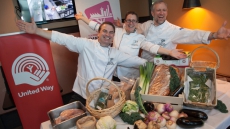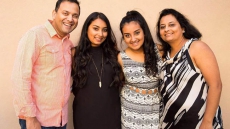TORONTO — Yvette Duffy's adventure of a lifetime began with years of meticulous planning.
The goal was to visit 16 countries in 10 months — an around-the-world ramble in which she and her husband would introduce their 10- and 13-year-old kids to an array of cultures, traditions and invaluable life lessons.
A family gap year, or even a months-long jaunt, can seem like an impossible dream for average Canadians. But many figure out a way, despite significant hurdles: finances, schooling, work obligations and of course, the kids' willingness to go along.
Before their trip, Duffy and her husband curtailed spending and drafted a list of countries to visit. Duffy deferred 20 per cent of her teacher's salary for four years so they could afford a year-long leave. They crunched the numbers again and again and tweaked their list of dream destinations.
As the trip approached, they sold their car and arranged a home swap for one of the costliest legs of the trip — three weeks in the south of France.
School was also an issue, since their son would essentially skip Grade 5 while their daughter would ditch Grade 8. So Duffy downloaded outlines of their academic requirements and vowed to homeschool on the road.
It was a risky plan, Duffy acknowledges, but the payoff was huge. Several months after returning to Toronto, she points to incredible memories, a tighter family bond, and confident kids.
"Their self-esteem definitely increased, their sense of independence increased, their knowledge of the world definitely grew," Duffy says of the impact of visiting locales including Iceland, northern Africa, the Himalayas, Thailand, Cambodia and Vietnam.
"They can now speak about places and issues in the world with more confidence and actually recognize the challenges that are facing the world around poverty, human rights, climate change."
Toronto mom Lisa Kisch says she indulged a long-held dream to see the world after her mother suddenly fell ill with terminal cancer.
Eager to distract herself from grief, Kisch dove into a plan to take her husband and two daughters on a seven-month jaunt to Mexico, the Virgin Islands, England, Portugal, Spain, Turkey, Israel, Italy and Croatia.
Reached at their first stop in Merida, Mexico earlier this year, Kisch rattled off a list of tips and tricks that could actually keep her finances in the black, thanks to a healthy passive income.
She's renting out their Toronto home and also found tenants for their cottage. Her online business as a network marketer for a beauty products company also promises a continued source of income.
Living and accommodation expenses should drop — depending on where they travel — and more savings come from reduced home and car insurance. Plus they won't be on the hook for the regular stream of birthday party gifts for her daughters' friends, she jokes.
Kisch used a broker to score seven months of health insurance for the whole family for $1,000, and will curb travel costs by hitting Europe in May before high-season starts. More affordable destinations like Portugal will alternate with pricier stops, like London.
While the budget fell into place, she hadn't anticipated how hard the move would be on her eight- and 10-year-old girls, who were sad to leave friends. Several days into the trip they were still crying, and she admits to being plagued by mom-guilt.
"It did surprise me that after five or six days they were still wishing they were home," says Kisch.
"And then I realized: You know what? You had a vision for this trip from the beginning for a reason and just keep that vision even while your kids are going through those ups and downs because ultimately that's what they're really going to learn from."
Lingering in one place allows for some semblance of a normal routine, she adds. Their mornings generally consist of schoolwork, an excursion and then lunch. Sightseeing is a leisurely jaunt, not the frenzied rush that can mar shorter trips, she says.
"If you have to see absolutely everything, they're going to be miserable, you're going to be miserable, they're not going to remember it anyway. The things they remember are: 'Remember when we walked to that place and we saw that shop and there was the lady with the flowers?'"
Micki Kosman and her husband were seasoned travellers before they had kids, but says hitting the road with little ones threw them for a loop.
Their younger selves had no qualms about booking cheaper hotels or even sleeping in a van — as they did during a stint in Australia. But when they took their son Cole on his first big trip at age two to the Philippines, their budget hotel and its lack of air conditioning just didn't cut it with the toddler. They've learned to upgrade, and stick to short-stay apartment rentals to keep things more home-like.
Kosman also makes a concerted effort to keep her kids connected to friends through Skype, video games and postcards.
"We kind of mistakenly thought we could kind of just slot kids in that backpacker life. And it's a little bit different," Kosman said during a quick visit to Calgary before returning to Belize, where her family was in the midst of a three-month escape.
Any journey now starts with making sure Cole, 11, and Jordan, 8, get plenty of input. She and her husband hoped their latest trip would be longer, for instance, but the kids scaled it back to just three months.
"Chuck and I make the final decisions, of course, but we talk to them to see how they feel about travelling and where they would like to go and we make all the decisions as a family," says Kosman, who runs various blogs including The Barefoot Nomad, Canadian Travel Insurance Review, and The Parent Spot.
This current trip includes Colombia, Ecuador and the kids' choice of the Galapagos Islands.
She says travel has made her kids more flexible and self-assured. Cole is responsible for his own suitcase and backpack. Both kids will order their own food in a Spanish-speaking restaurant as best they can.
"I think as parents we always have a tendency to over-protect a little bit and I'm always surprised how competent kids can be when you give them autonomy."
Duffy agrees, adding the caveat that such adventures are not for everyone. If your kids are struggling academically or you're not prepared to homeschool, the Toronto teacher discourages pulling them out for lengthy periods.
But it worked for her family, and Duffy says she doesn't regret it one bit.
"Was it hard for those four years on 80 per cent of my salary? For sure, as a family we had to make some tough decisions. But at the same time, if I had to go back and do it again, I'd do it again."
HOW 4 FAMILIES MANAGED TO LIVE NOMADIC LIFESTYLES ABROAD
Living abroad temporarily can seem impossible for families unsure of how to book time off work, fund their travels and keep schoolwork in check. Here's a look at how four families did it:
The Family: Lisa Kisch, her husband and two kids, ages eight and 10
Home: Toronto
Travel dates: Jan. 3, 2017 to July 2017 (return date uncertain)
Where they went: Mexico, the U.S. Virgin Islands, England, Portugal, Spain, Turkey, Israel, Italy and Croatia.
How they handled school: Kisch discussed pulling her kids out of Grades 3 and 5 with teachers, who were extremely supportive. But her school board doesn't provide materials for home schooling. Kisch loaded two e-readers with library books, and bought math workbooks for their grade levels. They spend 90 minutes each morning on writing and math, and research the area they happen to be in.
Income: Rental income from their family home and a cottage covers both mortgages and provides about $2,500 a month extra to fund the trip. Plus, Lisa continues to work online as a network marketing professional and receives a salary.
The cost: Mexico kicked things off with affordable comfort — they rented a large two-bedroom house with a pool in Merida for $2,500 a month. Uber rides, groceries and restaurants were cheap, while an iPhone SIM card cost $10 for three weeks of unlimited calls and texts, plus 300 megabytes of data. Day-to-day costs rose in St. Croix in the U.S. Virgin Islands, but over the course of the trip, Kisch expects they'll spend about as much as they would living in Toronto.
Travel tip: Quell tantrums by picky eaters with help from food ordering apps that do the translating for you. "The day I got here I tried to order pizza ... and it was an epic fail," Kisch recalls of her nascent Spanish-speaking skills. "So someone gave me this app and now I can order the pizza, I can pay cash, I don't even have to pay for it in advance."
———
Family: Micki Kosman, her husband and her two kids, ages eight and 11
Home: Kelowna, B.C.
Travel dates: Dec. 31, 2016 to end of March 2017
Where they went: Mexico, Belize, Columbia, Ecuador and the Galapagos Islands
How they handled school: They had already travelled a lot and learned to homeschool on the road with the help of B.C.'s online learning tools.
Income: The Kosmans run three blogs: The Barefoot Nomad, Canadian Travel Insurance Review, and The Parent Spot. Kosman says they make a little less than when she and Charles worked in IT, "but enough to live on."
The cost: They've budgeted about $4,500 a month for airfare, lodging, food and entertainment. But past trips have cost as little as $2,500 a month. They've cut costs at home by reducing car insurance, shutting off the hot water tank, turning the heat down, and putting phones and Internet plans on hold. They can blog while they travel, keeping income constant, while savings cover any shortfalls.
Surprises: Homeschooling is harder than it seems. "Some people are very naturally born to it, we found it a little tough. Because not only are you a parent but you become their teacher, so it involves a lot of structure and following up on doing the grunt work. I have a lot of respect for what teachers do."
———
Family: Yvette Duffy, her husband and two kids, ages 10 and 13
Home: Toronto
Travel dates: Sept. 7, 2015 to mid-June 2016
Where they went: Iceland, France, Spain, Morocco, Egypt, India, Thailand, Cambodia, Vietnam, Myanmar, Nepal, Turkey, Greece, Italy, England and Scotland.
How they handled school: Online sites were key for math — mostly IXL and the Khan Academy, but also the University of Waterloo's "Problem of the Week." Duffy downloaded ebooks and audio books related to each locale. Each kid blogged about things like blood cells and oxygen levels for their stop in Nepal, and "impossible loads" in Vietnam where motorcycles routinely carry massive cargo. When they returned, the kids went to a French summer camp before resuming studies at their French immersion school.
The cost: They sold their car, lived frugally and arranged a home swap for one of the costliest legs — three weeks in the south of France. Planning really began four years earlier when Duffy started deferring 20 per cent of her teacher's salary so she could take a year-long leave. They offset hefty airfare costs by using a travel app that scoured multiple airlines for deals.
Travel tip: Keep baggage light. "Our thing was to purchase our experience and not to acually purchase consumer goods unless we felt we were helping somebody in some way.... Sometimes (the kids) wanted things. And then the question was: 'Are you willing to carry that for the remainder of the trip?' And it always came down to: 'No.'"
———
Family: Dallas James, her husband and three kids, ages seven, 13 and 15
Home: Stouffville, Ont.
Travel dates: Feb. 24, 2016 to March 30, 2016
Where they went: The U.S. Virgin Islands
How they handled school: The kids each missed four weeks of school, but James scheduled the trip during a less-busy time of year for her oldest son. Teachers provided him with assignments for phys-ed, English, geography and drama to do in his spare time.
The cost: James continued to receive a passive income as a network marketer, while her husband combined vacation days and overtime hours to get a one-month paid holiday. James estimates they spent well over $10,000 on the month-long adventure: nearly $1,000 for a house-and-dog sitter, about $2,500 for flights to St. Thomas, and $6,000 to rent a boat. They saved by serving as their own crew and skipper. Groceries in the U.S. Virgin Islands are expensive — a box of Cheerios could run you $10, says James. So the family brought their own dry goods: rice, beans, cereals, pizza shells, pasta and canned food.
Lasting impact: "The biggest lessons were for my husband and myself — realizing that the break-neck pace of life is just not working for us. To the point where we're planning our next sailing trip.... And we're thinking of a bit of a radical life change. We're actually exploring the minimalism concept a bit."





